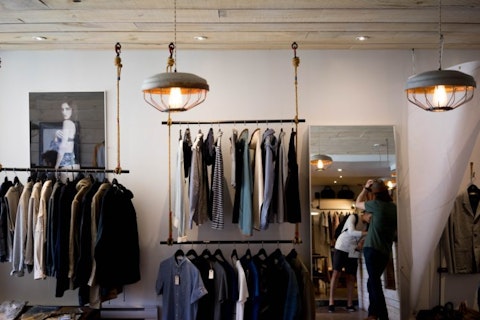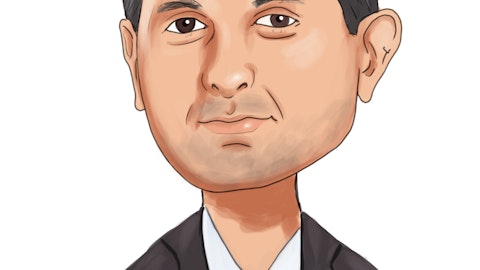Kirkland’s, Inc. (NASDAQ:KIRK) Q3 2022 Earnings Call Transcript December 2, 2022
Operator: Good morning, everyone, and thank you for participating in today’s conference call to discuss Kirkland’s financial results for the Third Quarter ended October 29, 2022. Joining us today are Kirkland’s President and CEO, Steve “Woody” Woodward; EVP and CFO, Mike Madden; and the company’s External Director of Investor Relations, Cody Cree. Following their remarks, we’ll open with the call for your questions. Before we go further, I would like to turn the call over to Mr. Cree as he reads the company’s safe harbor statement within the meaning of the Private Securities Litigation Reform Act of 1995 that provides important cautions regarding forward-looking statements. Cody, please go ahead.
Cody Cree: Thanks, Jason. Except for historical information discussed during this conference call, the statements made by company management are forward-looking and made pursuant to the Safe Harbor provisions of the Private Securities Litigation Reform Act of 1995. Forward-looking statements involve known and unknown risks and uncertainties, which may cause Kirkland’s actual results and future periods to differ materially from forecasted results. Those risks and uncertainties are more fully described in Kirkland’s filings with the Securities and Exchange Commission. I’d like to remind everyone this call will be available for replay through December 9, 2022. A webcast replay will also be available via the link provided in today’s press release, as well as on the company’s website at kirklands.com. Now I’d like to turn the call over to Kirkland’s Home President and CEO, Woody Woodward. Woody, over to you.

clark-street-mercantile-qnKhZJPKFD8-unsplash
Steven Woodward: Thank you, Cody, and good morning, everyone. We continue to operate our business in one of the more dynamic and unpredictable macro environments I’ve ever experienced in my career. From a global pandemic to geopolitical unrest to inflationary and recessionary pressures, the challenges we faced over the past few years have been tough. That being said, I’m proud of how resilient our organization has become at adapting to these challenges. As we head into 2023, I firmly believe we’re on track for a more stable year that will allow us to advance our transformation efforts. Before I address our strategic priorities for 2023, I’d like to discuss our third quarter. While volatility within the consumer environment made it difficult to predict sales patterns heading into the quarter, our financial results were generally in line with our internal expectations.
Importantly, we also remained well on track to achieve the year — our year-end inventory number and liquidity targets we set for ourselves. Consumer spending habits were volatile throughout the quarter. Early on, we saw an improvement in our trends throughout the month of August, which resulted in sales comp decline of only 2%. As we started the month of September, the momentum continued with our Labor Day Sale, backed by a strong promotional offering spurring customer demand. Unfortunately, business softened for the balance of September and into early October, as customers proved very price conscious and less interested in Harvest Decor than years past. This resulted in total comp sales being down around 7% for Q3. However, we began seeing improvements for the end of October, as our customer base shifted to holiday shopping.
I’ll dive further into what we currently are experiencing later in the call. During the quarter, we focused on weathering a difficult consumer spending environment by leaning on our improved messaging around pricing and online promotions to capture more of our discount oriented customer base. Our furniture and textile categories continued to perform well. While most other categories delivered performances in line with our internal projection. I’m encouraged to see that our furniture assortment is connecting with our customers and delivering fairly consistent results as we utilize a high low price, retail pricing strategy to generate more demand from our value oriented customers and we are gaining awareness for our high value merchandise items from customers that historically would have looked elsewhere.
Our AUR continues to grow, supported by larger ticket items and more products within the better invest categories compared to the prior-year. The macro environment — macroeconomic environment continues to hamper our trafficking conversion rates for both our stores and e-commerce due to the — though the compression in conversion rates was relatively minimal by the end of the quarter. Our store conversion declined around 1% by e-commerce declined around 3% both year-over-year comparisons. While conversion rates are down, it could have been much worse. This leads me to believe that customers are still connected to our assortments even in the midst of a challenging environment. After launching our in-home delivery service last quarter, we are seeing relatively healthy adoption from our customers.
While we don’t expect this to be a significant growth driver for the near-term, we’re pleased with our customer response so far, and expect in-home delivery to gradually become a more meaningful revenue stream in the future. We will continue to develop our back-end operations to ensure that our program remains scalable and easy to use for customers across our omni channel platform. As we move into the fourth quarter, we’re encouraged by the improvement in trend we have observed thus far in the holiday season. This momentum continued over Black Friday weekend, as we experienced increased demand in response to our promotion. And our results were in line with internal forecasts. The sell through we experienced thus far has allowed us to strengthen our balance sheet, which I’ll discuss in a minute.
While the consumer is being — is beginning to shift away from holiday decor spending at this point of season, we’re focused on capturing remaining holiday sales through a wide assortment of merchandise that can be used for gifting, and final decorating touches. With a clear promotional strategy in place, we will continue to look at our pricing strategy to ensure we are capturing our historically discount oriented customer base to drive further holiday spending as we close up season. Turning to our liquidity, I firmly believe we are on track to restoring and maintaining a healthier balance sheet. I’ll let Mike go into further detail shortly. But I’d like to highlight that we’ve already paid down $30 million of our borrowings so far in the fourth quarter, and expect to achieve a year-end target of net borrowing in the $10 million or less range.
We also continue to successfully work through our peak inventory position from August. In fact, we believe that we will be below our initial inventory, year-end inventory target, and now we expect to end the year with inventory in the $70 million to $80 million range. As we continue to convert existing inventory into cash, our margins will remain relatively depressed due to the high costs in which we procure that inventory. However, supply chain tensions are starting to ease and we expect to begin meaningfully recapturing margin in the New Year. Coupled with the disciplined cost structure we’ve implemented, our profitability has room to grow in 2023. We have identified several initiatives in the coming quarters that we believe will get us back on track with our transformation strategy.
After executing towards our critical objectives to manage inventory to appropriate levels and decrease our borrowing base, we can begin to focus more on other objectives, such as stabilizing store costs, growing e-commerce sales, and targeting high ROI projects and enable sales growth and improve. Our projects include using our Customer Data Platform or CDP to carefully manage price points and create targeted promotions, increasing the effectiveness of our marketing program, improving ROI on existing advertising spend. The reorganizing of our distribution channel to ensure optimum inventory distribution to stores and our e-commerce channel. Throughout this past year, we targeted our historical, our historically price sensitive customer base through career promotions and we look to continue to capture their demand by rebalancing our furnitures growth with diverse opening price points across multiple categories.
While we are committed to adding more high value items, we’re going to be thoughtful and curating items at price points that appeal to a broad base. The CDP will be an integral part to finding this right — the right price points for the right customers, as well as providing the data necessary for developing targeted promotions. We’ll also evaluate our marketing strategy to ensure that we’re maintaining the highest ROI for marketing dollar spend. As we acquire new traffic, we plan to invest in our stores increased coverage during peak selling hours, and in turn drive increased conversion rates. Our stores have undergone dramatic changes throughout the past year including refreshed arrangements, and it shifts towards an engaged selling culture by our team members.
We will continue our transformation and support our stores with additional investments in the coming quarters. With the development of our omni channel platform, it is important that we optimize our inventory distribution capabilities to provide added flexibility to our customers. We have identified technology investments to our existing point-of-sale and order management system that will enhance inventory availability across the system. We believe these investments will make our DC and delivery channels better optimized, improving margins, inventory turn, and leading to more efficient working capital use. Our e-commerce platform will also undergo operational enhancements to drive growth and support a better user experience. We look forward to sharing more with you on the upcoming months.
As you begin ordering new inventory between ’23, we will be maintaining a leaner inventory flow and delivering margin improvements throughout inbound freight cost reduction, and targeted initial market increases. While we’re uncertain of the sales landscape for next year, we’re diversifying our opening price points to ensure that we can operate successfully in a shifting market environment. Overall, I would like to reiterate, sticking with our managed inventories will probably level, improve our liquidity position and can set the table for stabilization in ’23. We’re firmly committed to our shareholders and creating best-in-class companies that can unlock the immense potential and value we believe it adds. Before I turn the call over to our new CFO Mike Madden, I’d like to officially welcome him back to Kirkland’s Home.
Mike’s substantial executive experience, and previous long tenure with this organization has helped him transition quickly into our operation and make an instant impact as we navigate through the current macroeconomic landscape. Mike’s deep understanding of our business model makes him a superb fit to lead our financial operations and support the execution of our long-term growth strategy. And I’m grateful to have him back on our team. With that, I’ll now turn the call over to Mike, who will provide detailed commentary on our performance vertical and our outlook. I’ll be back for the Q&A to answer any questions you might have. Mike, the floor is yours.
See also Jim Cramer’s Dividend Stocks To Buy and 25 Richest People in the World.
Mike Madden: Thanks, Woody. Good morning, everybody. I’m pleased to be back in Kirkland’s, where I’ve spent a large part of my career and I’m looking forward to contributing to a successful recovery of the business. While we do have a lot of work to do, I believe in the long-term opportunity that’s before us to make Kirkland’s Home a dominant, especially home furnishings retailer. As Woody outlined, our third quarter performance was focused on working within a difficult sales environment combined with margin pressures from elevated inventory levels, and higher freight and supply chain costs. I’ll go over the details of the P&L in a minute. But I want to start with a summary of our current financial position. Since our last update, our primary focus has been on improving our liquidity position by converting excess inventory into cash, reducing the borrowings under our revolving credit facility and returning our accounts payable to normal levels.
Despite the challenges we faced in the third quarter, we made considerable progress in each of these areas. As expected, our revolver borrowings peaked at $60 million during the third quarter, and we’ve reduced our borrowings by $30 million thus far in the fourth quarter, leaving $30 million currently outstanding. Our inventory position at the end of Q3 which is traditionally our peak period was $126.3 million and that’s down from $141.7 million at the end of Q2, as we emphasize clearing excess inventory and reducing our receipt plan for the balance of the year. This is likewise influencing our accounts payable which dropped from $61.6 million at the end of Q2 to $47.2 million at the end of Q3. For the balance of fiscal 2022, we will continue to prioritize improving our liquidity position heading into 2023 by converting inventory into cash, creating top line momentum through targeted promotional activity.
As Woody mentioned, we expect our net borrowings outstanding at the end of the year to be $10 million or less, and our inventory balance to be in the range of $70 million to $80 million. Moving to our third quarter results, net sales were $131 million compared to $143.6 million in the year-ago quarter, which includes a 3.5% decline in store count, and a comparable sales decline of 7%. The comparable sales result was driven by year-over-year decline in store and online traffic and conversion partially offset by an increase in average ticket. E-commerce was 27% of the total sales in the quarter, which was similar to the prior-year. Breaking down sales within the quarter, we had a total comp decrease of 3% in August, a decrease of 10% in September, and a 6% decrease in October.
Comp trends improved in the latter part of October and into the early part of Q4. Gross profit margin declined 970 basis points to 25% of sales compared to 34.7% in the prior-year quarter, I’ll break out this decline into five components. First, merchandise margin declined 480 basis points to 52.9% versus 57.7% in the prior-year quarter. Heavier discounting associated with our efforts to reduce inventory levels and higher inbound freight rates led to this decrease. Inbound freight rates spiked in late 2021 and early 2022 and much of the product that’s sold through in Q3 carry the impact of higher freight rates and cost of goods. Second, central distribution costs increased 290 basis points to 7.2% of sales from 4.3% in the prior-year quarter.
This increase was largely due to operational inefficiencies in our distribution centers, resulting from elevated inventory levels and uneven product flows. These costs spiked during the first and second quarters of this year and were capitalized as the underlying inventory was held prior to sale and are now being recognized in the P&L as inventory sells through. This is an important call out because this timing is atypical. The third quarter is usually a period of rising inventory levels and supply chain costs, with costs build up being recognized in the P&L during the fourth quarter. This year, with inventories peaking much earlier and heavier than normal and order flows curtailed for the back half of the year, inventory levels declined sequentially from Q2 to Q3.
However, the inventory that sold through in Q3 had the higher distribution costs from earlier in the year attached, which negatively impacted our operating results. Third, store occupancy costs increased 130 basis points to 10.8% of sales from 9.5% in the prior-year quarter, due to deleverage from a lower sales pace. Fourth, outbound freight costs, including both store and e-commerce shipping expenses, increased 110 basis points to 8% of sales from 6.9% in the prior-year quarter. The increase was primarily at the store level and due to additional routes deployed to move more products on elevated inventory level. Additionally, shipping rates and fuel costs were higher than in the prior-year. E-commerce shipping costs were up slightly versus the prior-year reflecting the launch of our in-home delivery service.
And lastly, depreciation included in cost of sales decreased 40 basis points to 1.9% of sales from 2.3% in the prior-year quarter. Total operating expenses were $39.4 million or 30.1% of sales, compared to $40.8 million or 28.4% of sales in the prior-year quarter. A reduction in advertising expense of over $3 million drove the overall decline. This was offset somewhat by increases in insurance and corporate salaries due to the collection of a property insurance claim and favorable accrual adjustments in the prior-year. The increase as a percentage of sales was primarily due to the lower sales pace. Adjusted EBITDA excluding impairment and other minor non-operating expenses was negative $1.7 million, compared to $14.8 million in the prior-year quarter.
Our normalized tax rate in the third quarter was 24% compared to 25% in the prior-year quarter. Adjusted loss per share, which excludes non-cash impairment, normalizes the tax rate, and excludes other minor non-operating adjustments was $0.38 compared to an adjusted earnings per share of $0.51 in the prior-year. GAAP loss per share, including these items was $0.58 compared to earnings per share of $0.51 in the prior-year quarter. While we are not providing specific guidance for the fourth quarter, we do want to provide some color around our expectations for sales and margin performance as well as our outlook for liquidity and other key balance sheet components. Sales thus far in Q4 have improved from Q3 trends for the fiscal month of November, which ended this past Saturday.
Comparable sales were approximately flat. This is something we anticipated as we were in a better in-stock position on our holiday seasonal category this year, and as Woody mentioned the assortment has performed well. While we’re optimistic about the sales results we experienced in November, we’re being cautious in our expectations. And within our internal forecasts, we’re not extrapolating the sequential improvement we experienced in November for the remainder of the quarter given the persistent consumer volatility. From a margin perspective, heavier promotional activity will continue for the remainder of the year as we reduce inventories and reposition the assortment for 2023. We expect to again show sequential improvement in our gross profit margin during Q4.
But we will still be below last year due to an anticipated merchandise margin decline in the range of 300 to 400 basis points due to the increase in promotional activity. We also expect that we will experience some additional overhang from the spike in freight and distribution center costs earlier in the year as inventory continues to sell down. We expect some deleverage on the fixed components of our gross profit margin, but the impact should be less than what we’ve experienced year-to-date. While we’re seeing inbound freight rates decline, we won’t see a significant benefit in our financials until the first part of 2023 as most of the inventory, we will sell for the remainder of this year shipped at higher freight rates. However, with inventory levels and freight costs declining, our overall margin profile for 2023 is setting up to be much improved.
From a liquidity perspective, as I mentioned earlier, we anticipate paying down our revolver to a net borrowing position of $10 million or less by the end of the year, with inventory levels in the range of $70 million to $80 million. Finally, as to capital allocation. Our first priority is to reestablish a level of liquidity that allows us to operate the business flexibly and to confidently pursue our long-term goals while maintaining downside protection in an unpredictable environment. Second, we want to invest cash flow back into the business and high return projects that advance our long-term goals to be a Premier Home Furnishings retailer. Share repurchases and dividends have been important components of our capital allocation strategy in the past, and we would expect to use them again in the future once our near-term goals have been achieved.
Looking ahead to 2023, we do not expect the inventories to fluctuate greatly during the first half of the year. And we expect a more traditional seasonal inventory build-up ahead of next holiday shopping season. Leaner inventories will further improve our overall working capital position and combined with continued expense control should lead to reduced utilization of the credit facility as compared to fiscal 2022. Thank you all for joining us today. And once again, I’m very glad and thank Kirkland’s Home for my warm welcome back. I look forward to assisting this outstanding organization as we embark on the next chapter of our journey. Operator, we’re now ready to take questions.
Follow Kirkland's Inc (NASDAQ:KIRK)
Follow Kirkland's Inc (NASDAQ:KIRK)
Operator: Thank you, sir. We will now begin the question-and-answer session. Our first question comes from Anthony Lebiedzinski from Sidoti & Company. Please go ahead.
Anthony Lebiedzinski: Good morning, Woody and Mike and welcome back Mike to Kirkland’s. I guess first, as you look to stabilize comp sales and increase e-commerce sales, what are the main demand levers that you expect to use? I know you’ve been sort of driving a lot of promotions now. But how should we think about that near-term and longer term as you look to turn around the business. So just curious to get your thoughts on that first?
Steven Woodward: Yes, one thing is making sure that we have a solid promotional strategy. I think we’ve been a little bit schizophrenic in past years about our discounting process. So what we did was we went through and we made sure that we made sure that our IMU was slightly increased and that we would be able to bake in the right promotional levels for driving both e-commerce and store business. The other thing was just also working diligently on the store experience, the cultural experience of coming into a Kirkland’s store, which has been changing since we’ve been a retailer that sold items to a retailer that’s now selling full room home furnishings, we’ve been focused on that. And then e-commerce has been a really intense part of our focus on making sure that we have the right platform, the customer experience, using our new CDP to be able to detail out, how do we make sure that we’re sending the right emails to the right customer base, and not having to be promotional across the base, and really taking advantage of the fact that, we’ve got lots of new customers coming into the organization, and we want to treat them a little differently than what we’ve done in the past with some of our core customers that have expected a highly promotional environment.
Anthony Lebiedzinski: Okay, thanks for that. And then, in terms of your operating expenses, I mean, they were down looks like 3.5% in the quarter. How should we think about that as far as, I know you’re obviously looking to certainly have firm cost controls, but just there’s still inflationary pressures out there. So just overall, what are the different puts and takes as you look to manage your operating expenses effectively?
Mike Madden: Yes, Anthony, we continue to maintain that strict cost control posture. If you look at what the big influencers are there in general, I mean, we can talk about third quarter in particular, but in general marketing expense, we’re kind of holding that flat as we think ahead, we want to reposition some of that spend to higher return opportunities. But that’s how I would think about it going forward. Woody just mentioned one other big area where we’re really looking at closely and that’s store payroll, we would like to layer in a little bit more there. But we’re going to test into that really, and understand what layering in a little bit more in the way of hours and coverage does for us. But that is an area to Woody’s point just now that we think we can benefit from with an enhanced focus at the store level on really servicing the customer.
So that is one area that I think about it now as we’re going to manage it very tightly as we have been, but we want to invest there, as we see things that really worked for us.
Anthony Lebiedzinski: Got it, okay. And then in terms of your store base, so you closed one store, you opened one store, Mike now that you’ve been with the company for a few months back, what are your thoughts as far as just additional store closings and perhaps maybe even some store openings?





